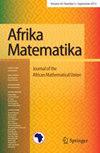\(\Delta _h\)-Appell versions of U-Bernoulli and U-Euler polynomials: properties, zero distribution patterns, and the monomiality principle
IF 0.9
Q2 MATHEMATICS
引用次数: 0
Abstract
This paper explores the properties, generating functions, recurrence relations, and summation formulas of a novel class of polynomials, referred to as \(\Delta _h\)-type U-Bernoulli and \(\Delta _h\)-type U-Euler polynomials. We delve into the characterization of these polynomials, including the monomiality principle, and derive the corresponding derivative and multiplicative operators. Additionally, we provide computational values in tables and visually appealing representations of the zeros of these polynomials in figures, offering a comprehensive understanding of their behavior.
\(\Delta _h\)-阿佩尔版的u -伯努利和u -欧拉多项式:性质,零分布模式,和单项式原理
本文探讨了一类新的多项式,即\(\Delta _h\)型u -伯努利多项式和\(\Delta _h\)型u -欧拉多项式的性质、生成函数、递归关系和求和公式。我们深入研究了这些多项式的表征,包括单项式原理,并推导了相应的导数和乘法算子。此外,我们在表格中提供了计算值,并在图形中提供了这些多项式的零的视觉吸引力表示,从而提供了对其行为的全面理解。
本文章由计算机程序翻译,如有差异,请以英文原文为准。
求助全文
约1分钟内获得全文
求助全文

 求助内容:
求助内容: 应助结果提醒方式:
应助结果提醒方式:


